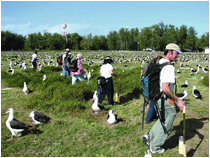Management in the Modern Era
 Due to its remote location, the property has suffered relatively few major human perturbations. During the 19th and 20th centuries, the Northwestern Hawaiian Islands faced many extractive
uses as Honolulu became an important port in the Pacific, and provided a convenient jumping-off point. Extractive activities included whaling, hunting of monk seals and birds, and fishing for shark, turtle, sea cucumbers, and pearl oysters. Terrestrially, several of the islands were leased for guano extraction, and feathers and albatross eggs were collected. The most significant activities of this nature occurred on Laysan and Lisianski Islands and Midway Atoll. All of these activities ceased by the early 20th century, when American President Theodore Roosevelt acknowledged the need to protect the region’s birds, setting aside the islets and reefs of the Northwestern Hawaiian Islands (except Midway Atoll) as the Hawaiian Islands Reservation. Since then, numerous efforts have been made to eradicate alien species, and to protect, preserve, maintain and, where appropriate, restore natural communities, including habitats, populations, native species, and ecological processes as a public trust for current and future generations. The lands and the waters of Papahānaumokuākea have always been remote, and therefore not heavily accessed. Thus, use of the natural resources of the property was historically minimal and sporadic. In recent years, human access to the property has been primarily limited to commercial fishing, conservation and management, and research activities. At times, longline, crustacean and bottomfish fisheries have operated in Papahānaumokuākea. However, even before the designation of the National Monument, only the bottomfish fishery continued to operate under a limited-entry system. All commercial fishing ceased in 2010, as per terms of Presidential Proclamation 8031. Current management strategies result in careful scrutiny of activities within the property, with particular attention to cumulative impacts. This oversight ensures that any potential negative human impact to the natural resources of Papahānaumokuākea will be negligible. Management and conservation activities that take place within Papahānaumokuākea Marine National Monument undergo the same rigorous review and permitting process as scientific activities. Examples of management and conservation activities include the continuation of a decade-long effort to remove marine debris from the coral reefs and beaches of the property, alien plant species removal projects on several islands, and restoration of native plant and animal species.
Due to its remote location, the property has suffered relatively few major human perturbations. During the 19th and 20th centuries, the Northwestern Hawaiian Islands faced many extractive
uses as Honolulu became an important port in the Pacific, and provided a convenient jumping-off point. Extractive activities included whaling, hunting of monk seals and birds, and fishing for shark, turtle, sea cucumbers, and pearl oysters. Terrestrially, several of the islands were leased for guano extraction, and feathers and albatross eggs were collected. The most significant activities of this nature occurred on Laysan and Lisianski Islands and Midway Atoll. All of these activities ceased by the early 20th century, when American President Theodore Roosevelt acknowledged the need to protect the region’s birds, setting aside the islets and reefs of the Northwestern Hawaiian Islands (except Midway Atoll) as the Hawaiian Islands Reservation. Since then, numerous efforts have been made to eradicate alien species, and to protect, preserve, maintain and, where appropriate, restore natural communities, including habitats, populations, native species, and ecological processes as a public trust for current and future generations. The lands and the waters of Papahānaumokuākea have always been remote, and therefore not heavily accessed. Thus, use of the natural resources of the property was historically minimal and sporadic. In recent years, human access to the property has been primarily limited to commercial fishing, conservation and management, and research activities. At times, longline, crustacean and bottomfish fisheries have operated in Papahānaumokuākea. However, even before the designation of the National Monument, only the bottomfish fishery continued to operate under a limited-entry system. All commercial fishing ceased in 2010, as per terms of Presidential Proclamation 8031. Current management strategies result in careful scrutiny of activities within the property, with particular attention to cumulative impacts. This oversight ensures that any potential negative human impact to the natural resources of Papahānaumokuākea will be negligible. Management and conservation activities that take place within Papahānaumokuākea Marine National Monument undergo the same rigorous review and permitting process as scientific activities. Examples of management and conservation activities include the continuation of a decade-long effort to remove marine debris from the coral reefs and beaches of the property, alien plant species removal projects on several islands, and restoration of native plant and animal species.
